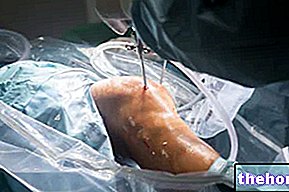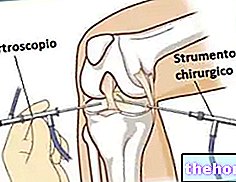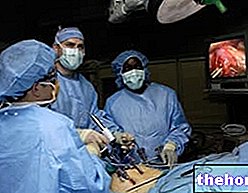Generality
Ileostomy is a delicate and complex surgical procedure, which consists in the deviation of the ileum (or, more rarely, of a section of intestine that precedes it) towards an opening made specifically on the abdomen.

To make ileostomy necessary may be some diseases of the large intestine, such as colorectal cancer, Crohn's disease, ulcerative colitis, etc.
There are three different ways to perform an ileostomy; the choice of a specific surgical approach is up to the doctor and depends on the severity of the intestinal pathology, which makes the operation essential.
Brief reminder of the intestinal anatomy
The intestine is the portion of the digestive system between the pylorus and the anal orifice. From an anatomical point of view, doctors divide it into two main sectors: the small intestine, also called the small intestine, and the large intestine, also called the large intestine.

The large intestine is the terminal tract of the intestine and digestive system. It begins at the ileocecal valve and ends at the anus; it develops in 6 sections (cecum, ascending colon, transverse colon, descending colon, sigma and rectum), is about 2 meters long and has an average diameter of about 7 centimeters (hence the name of large intestine).
What is ileostomy
Ileostomy is a delicate surgical procedure which involves the deviation of the small intestine - generally the ileum - towards an opening made in the abdomen.
This opening, defined by the name of stoma, serves for the anticipated escape of the faeces, ie without their normal transit through the large intestine and the anus.
For obvious reasons, surgeons make the stoma in such a way that it can be connected to a "special waterproof bag, capable of accommodating fecal material.
In other words, ileostomy is the operation by which surgeons shorten the normal bowel path and create an orifice on the abdomen, which effectively replaces the functions of the anus.
Statistical data
Ileostomy is a fairly common operation. For example, according to an Anglo-Saxon survey, in England, the number of ileostomies performed annually is approximately 9,900.
IS IT A TEMPORARY OR PERMANENT REMEDY?
Ileostomy can be a temporary (reversible ileostomy) or permanent (definitive ileostomy) modification to the normal transit of stool.

Bags for ileostomy
If it is a temporary solution, another surgical operation is planned some time later, during which the operating doctor puts the ileum in communication with the large intestine.
When you do
Doctors perform an "ileostomy" when the large intestine - especially the section known as the colon - is damaged, inflamed, or not functioning properly.
To cause this series of alterations are some particular intestinal pathologies / conditions, including:
- Colorectal cancer (or colorectal cancer). Colorectal cancer is the most common malignant neoplasm of the gastrointestinal tract and is a leading cause of cancer death in both men and women.
From a therapeutic point of view, the main treatment is colectomy, during which the operating surgeon removes the diseased section of the intestine.
The choice to also resort to ileostomy depends on the size and position of the removed section. The opening can be temporary or permanent, depending on whether or not the conditions exist for a recovery of the functionality of the remaining colorectal tract. - Crohn's disease. It is an autoimmune disease, belonging to the category of so-called inflammatory bowel diseases. The symptoms that characterize it are diarrhea, abdominal pain and a feeling of recurrent fatigue.
Ileostomy is not the first choice treatment for Crohn's disease. However, it can become so in all those cases where, according to doctors, temporary isolation of the inflamed bowel from the stool is of benefit to the latter. - Ulcerative colitis. It is another chronic inflammatory bowel disease that specifically affects the large intestine (primarily the rectum and then the colon). Its typical symptoms are bloody diarrhea, abdominal pain and mucous discharge.
The expected treatment is usually pharmacological. In fact, doctors resort to ileostomy only when the drugs do not produce the desired results.
The ileostomy can be temporary or permanent, depending on the severity of the inflammation and the more or less concrete possibilities of a reduction in the inflammatory state. - Intestinal obstruction. Doctors speak of intestinal obstruction when the bowel is blocked and does not allow what flows inside it to progress regularly. Bowel obstruction is a "medical emergency, because, where blockage occurs, bleeding, infection and intestinal perforation could occur.
Treatment generally involves a colectomy, followed by a colostomy (ie the deviation of the colon towards an "opening made in the abdomen") or an "ileostomy. The choice falls on the ileostomy when the intestinal obstruction affects the entire colon."
The solution may have a temporary or permanent duration, depending on the severity of the situation. - Familial adenomatous polyposis (FAP). It is a rare intestinal pathology, characterized by the formation of particular benign precancerous lesions, inside the colon and rectum. These benign precancerous lesions are called polyps and have a high tendency to become malignant. In fact, 99% of patients with FAP develop colorectal cancer sooner or later in the course of life.
Typically, treatment consists of a "preventive colectomy operation, followed by a permanent" ileostomy. - Intestinal injury from abdominal trauma. The trauma to the abdomen that can cause an intestinal injury are: a "stab wound", a gunshot wound, a workplace accident, a car accident and so on.
Injuries resulting from such traumatic events may require a partial colectomy, followed by a temporary "or, in particularly severe cases, permanent" ileostomy.
Preparation
Ileostomy is a rather complex operation, therefore it requires special preparation.
First, the medical team - usually made up of a surgeon, qualified nurses and an anesthetist - must determine whether the candidate patient is capable of undergoing a surgical operation or not. Therefore, it prescribes a series of clinical tests - including blood tests, urine tests, electrocardiograms, blood pressure measurements, clinical history analyzes, etc. - to be carried out several days before the presumed intervention date.
If the outcome of these tests is positive (therefore the conditions necessary for carrying out a surgical procedure exist), the surgeon and assistants move on to the second stage of preparation, the one in which they illustrate to the patient the pre-operative recommendations, the methods of intervention , possible risks, post-operative indications and canonical recovery times.
PRE-OPERATIVE RECOMMENDATIONS
The main pre-operative recommendations are:
- A few days before the ileostomy, stop any possible treatment based on antiplatelet drugs (aspirin), anticoagulants (warfarin) and anti-inflammatory drugs (NSAIDs), because these drugs, by reducing the clotting capacity of the blood, predispose to severe bleeding.
- On the day of the procedure, go on a complete fast from at least the previous evening and with the bowel empty and possibly "clean".
Such a prolonged fast is explained by the fact that ileostomy requires general anesthesia.
As regards emptying and "cleaning" the intestine, for the former, doctors recommend taking a laxative solution several hours before the operation; for the latter, they prescribe antibiotics. - Ask a relative or a close friend in time to be free on the day of the surgery to offer their assistance, especially at the time of discharge.
Procedure
The first phase of the procedure consists in the implementation of the general anesthesia, the second in the realization of the intestinal deviation and the opening on the abdomen (abdominal stoma).
There are three different types of ileostomy: terminal ileostomy (in English, end ileostomy), the "loop ileostomy (in English, ileostomy loop) and ileo-anal anastomosis (in English, ileo-anal pouch).
To distinguish one type of ileostomy from another is the way in which the ileostomy is performed.
The choice of the type of ileostomy to adopt basically depends on the reasons that make the intervention necessary.
IMPLICATIONS OF GENERAL ANESTHESIA
General anesthesia implies that the patient is asleep and completely unconscious during the entire procedure.
To administer the anesthetic drugs by venous route or by inhalation (N.B: the administration of these drugs lasts until the end of the operation), is a doctor specialized in anesthesia practices (ie an anesthetist).
Typically, the anesthetic works within 10-15 minutes. Only after falling asleep does the treating physician have the green light to begin treatment.
From shortly before the anesthesia and throughout its duration, the patient remains connected to a series of instruments that measure his heart rate, his blood pressure, his body temperature and his level of oxygen in the blood. , there is a continuous monitoring of his vital signs and an immediate and real-time feedback of any minor changes.
TERMINAL ILEOSTOMY: WHAT HAPPENS?
The surgeon begins the terminal ileostomy by making a first incision in the abdomen, through which he separates the ileum from the rest of the intestine (ie the large intestine).
Then, he makes a second incision, smaller than the previous one, on the right abdominal region, in correspondence with the point of union between the ileum and the cecum. of small intestine, separated shortly before, towards the future stoma.
At the level of the stoma, shape the edges of the intestinal tract with the contours of the opening on the abdomen and apply the sutures that serve to block the deviation.
The stump of the large intestine, isolated because it is not sick, can undergo two different fates:
- If there is no chance of its recovery (for example in the case of cancer), the surgeon removes it (colectomy).
- If an improvement in his condition is possible, the surgeon leaves him in place for possible future restoration of a normal gastrointestinal canal.
Terminal ileostomy usually has a permanent purpose and is particularly appropriate in cases of intestinal obstruction, colorectal cancer, severe traumatic injury and familial adenomatous polyposis.
ANSA ILEOSTOMY: WHAT HAPPENS?
The surgeon begins loop ileostomy operations by making an incision on the right side of the abdomen, where the small intestine generally ends.
Then, through this incision, he "takes" a "loop of the ileum, drags it to the surface (ie outside the abdominal cavity), joins it with sutures at the edges of the incision itself and, finally, cuts it into the its uppermost part so as to form two distinct openings. An opening represents the terminal part of the overlying gastrointestinal tract and the point from which the patient will expel stool (proximal canal); the other opening is the initial part of the large intestine stump to be isolated, ending with the anus and from which only mucus emerges (distal canal).

Practiced especially in the presence of Crohn's disease and ulcerative colitis, loop ileostomy is generally a temporary solution. Not surprisingly, after all, surgeons cut the loop of the ileum, so that it is easier to restore the loop. normal intestinal anatomy.
ILEO-ANAL ANASTOMOSIS (ILEO-ANAL POUCH): WHAT HAPPENS?
The ileo-anal anastomosis consists in the operation of joining the ileum with the anus. At the point of union, the surgeon folds the terminal portion of the ileum in two (forming a sort of elbow), connects the two adjacent areas (so as to double the internal space) and makes these a sort of pocket (pouch).
After its creation, the pocket needs to remain isolated for several weeks, so that the small surgical wounds and the various sutures present on it heal and settle down completely.
All this implies that, at the same time as the ilioanal anastomosis, the surgeon also performs a temporary loop ileostomy, to allow the patient to expel the stool while the healing process takes place.
Surgical significance of anastomosis
Surgical anastomosis is the bite (ie the union), after resection, of two parts of the same viscera or of two different viscera.
After the procedure
At the end of the ileostomy, a hospital stay is expected which can last from a minimum of 3 to a maximum of 10 days. The duration of hospitalization generally depends on the severity of the intestinal problem that made the ileostomy surgery necessary. .
During hospitalization, the medical staff scrupulously provides for the patient:
- It periodically monitors, especially in the initial phase, its vital parameters (blood pressure, cardiac activity, etc.).
- It provides him intravenously with all the nutrients he needs.
- He subjects him to catheterization (for the elimination of feces), at least for the first few days.
- He explains the various stages of recovery and the most important post-operative recommendations.
THE STOMA AFTER THE OPERATION AND IN THE FOLLOWING WEEKS
Immediately after the operation, the region occupied by the stoma shows clear signs of inflammation and is swollen.
However, as the weeks pass, both the inflammation and the swelling gradually diminish, until their definitive disappearance. Generally, the situation normalizes after about 8 weeks.
Finally, it is important to remember that, until the surgical wounds have healed completely, an unpleasant odor may come from the stoma.
BAG MANAGEMENT AND STOMA HYGIENE
During hospitalization, a member of the medical staff (usually a nurse) teaches the patient how to care for the stool bag (when to change it, when to know it is full, etc.) and how to keep the stoma and surrounding area clean. .
A scrupulous management of the bag and a "careful cleaning of the stoma reduce the risk of" infection.
AFTER THE RESIGNATION
After discharge, the patient should lead a quiet life, without excessive effort, for at least 2-3 months. Neglecting this indication can strongly affect the healing process and the success of the operation.
Flatulence and a strange feeling of pain in the stomach very often characterize the first weeks following discharge.
Risks and Complications
As with any surgery, there is also the risk of:
- Internal bleeding
- Infections
- Formation of blood clots in the veins (deep vein thrombosis)
- Stroke or heart attack during the operation
- Allergic reaction to anesthetic drugs or sedatives used during the surgery
Furthermore, at the end of the operation, due to the extreme delicacy that characterizes the intervention, various complications may occur, including:
- Stoma occlusion. The stoma could become occluded due to an accumulation of food inside the intestine. In the presence of an occlusion, typical symptoms are: nausea, abdominal cramps and reduced stool production.
If these complaints last for several hours, it is best to contact your doctor or go to the nearest hospital. - Dehydration. The large intestine is the intestinal tract that absorbs most of the water contained in the stool. In those who undergo an ileostomy, the passage of feces through the large intestine no longer takes place and this favors the loss of useful fluids and dehydration. To avoid such an inconvenience, doctors recommend drinking plenty of water.
- Loss of mucus from the rectum (when not removed). If the rectum and sigma are still present, it is likely that, despite being isolated, they still produce mucus and disperse it through the anus. This is a rather annoying inconvenience, because it requires the patient to go to the toilet from time to time to clean up the various spills.
- Vitamin B12 deficiency. Often, after an ileostomy, the part of the intestine that absorbs most of the vitamin B12 is isolated or in any case no longer performs this function. This can lead to a deficiency of this organic substance.
Severe vitamin B12 (or cobalamin) deficiencies can lead to nerve problems, such as memory impairment or damage to the spinal cord. - Various problems with the stoma. The main ones are: stomal stenosis (or narrowing), stomal prolapse (or protrusion of the stoma), irritation / inflammation of the stoma, parastomal hernia and stomal retraction.
- Rectum phantom. It is a particular condition that causes, in the patient with ileostomy, the need to go to the toilet, as before the operation. However, it is not a real need, because the large intestine and, in particular, the rectum are excluded from the passage of stool.
- Pouchite. It is the inflammation of the pocket, created during the ileo-anal anastomosis.
- Lethargy and unexplained tiredness
- Wheezing
- Feeling of recurring fainting
- Headache
- Palpitations
- Tinnitus
- Loss of appetite
Results and daily life
Despite imposing some limitations and some rigid behaviors, ileostomy still allows you to lead an active and satisfying social life.
Patients must pay close attention to diet - especially in the first phase of post-operative recovery - and to the management of the stool collection bag.
Regarding physical activity, exercise and sexual intercourse, it is good to follow the instructions given by the surgeon who performed the ileostomy to the letter. After all, each procedure represents a case in itself.




.jpg)











.jpg)











